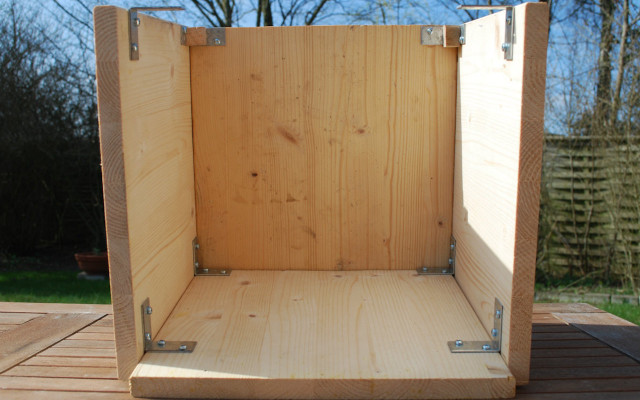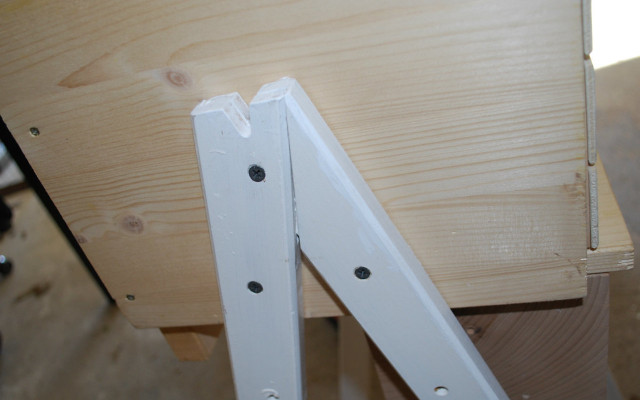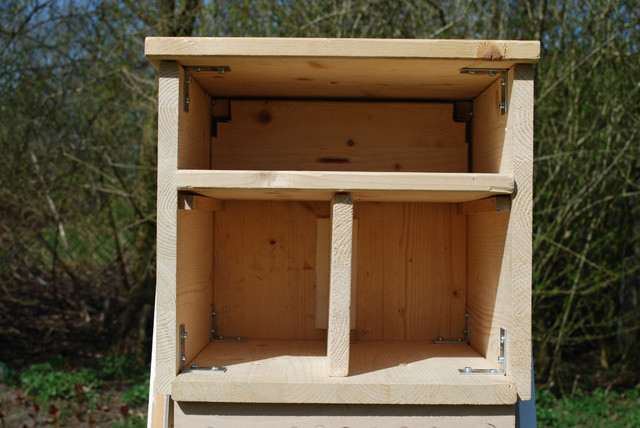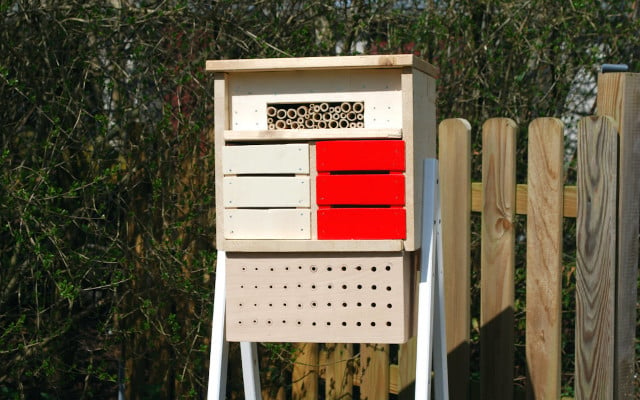We’ll show you how you can help insects survive, by building a DIY bug hotel. Bees and other insects can use this house or “hotel” as a safe place to make their nests and spend the winter months.
Why Build an Insect House?
Humans interfere more and more with the natural habitats of insects, including bees, by:
- constructing infrastructure
- using industrial farming practices
- using pesticides
- causing pollution
Because of these things, there is less and less space for bugs to safely exist, and their populations are dwindling.
By building an insect house, bee or bug hotel, you can help undo some of the damage done by humans to the environment. The constructions help different kinds of insects find a place to build their nests, and to help them survive the winter.
Tip: If you don’t have the space for a bug or bee hotel, try planting some flowers for bees somewhere in your backyard, or in a pot on your balcony.
Building a Bug Hotel: Before You Start

An insect house will only be accepted by the bugs you are trying to attract if it meets the proper criteria. If you want insects to want to live in your bug hotel, it is important to pay attention to a few things. First and foremost, the material should be
- dry and
- untreated.
Just like people, insects have preferences when it comes to where they live. They like places that are sunny and warm, but not exposed to weather conditions. They also need clear and easy accessibility.
For specific types of insects, you’ll need to pay attention to specific things.
1. Bug Hotel for Wild Bees
Wild Bees look for their nesting place in spring. Wild bees are cavity-nesting, meaning they lay their eggs in small holes in dead wood or hollow stems, which they then seal. If you’re building a bee hotel in spring, you’ll need to keep a few things in mind:
Wood Bee Hotels
- Many bug hotels (like the one you can build in our step-by-step guide below) include wooden blocks with holes drilled into them. When choosing the wood for this block, it is very important to use only untreated wood that is very hard, like ash or beech. If you use soft wood or wood that has just been cut, there’s a good chance that you’ll create splinters when you drill the holes, which could injure and kill the bees you’re trying to protect.
- Drill differently sized holes into the wood. This will help your bee hotel be attractive for different sorts of wild bees.
- The holes shouldn’t penetrate the wood block all the way through. They should remain closed on one side.
Bamboo Bee Hotels
- Avoid using bamboo that is soft or wet, so as to not create splinters.
- Use bamboo poles that have a variety of different diameters, so that different kinds of wild bees will feel comfortable laying their eggs.
2. Bug Hotel for Ladybugs
Ladybugs search for a place to nest during autumn. They swarm out in groups looking for a suitable place for their wintertime rest. If you’re building a bug hotel for ladybugs, pay careful attention to placing it in an area that is protected from the weather.
3. Bug Hotel for Lacewings
Lacewings like the color red. If you want to build an insect hotel for them, all you have to do is use some non-toxic red paint, and you’re in business. Like ladybugs, lacewings looks for a place to spend the winter in the autumn.
Warning: Certain types of wild bees make their nests in the ground. They will need different kinds of bee hotels.
Building Your Own Insect House: DIY Guide



To build you own bug hotel, you’ll need the following materials:
- Scaffolding
- 3 panels, one for the base, and two for the sides: 15×15 inches, 1/2 inch thick
- Back panel: 14×12, 1.5, 1 inch thick
- Roof panel
- 8x brackets (4 for the bottom, 4 for the top)
- 32x #6 1/2 inch wood screws
- 9x #12 1 inch wood screws
- 3x #14 2.5 inch wood screws
2. Wooden Block
- Wooden block about 10x6x6 inches
- Drills bits: 5/32, 11/64, 3/16, 13/64, 7/32, 15/64, 1/4, 17/64, 9/32, 5/16
- Pencil
- Pipe cleaners
- Sandpaper 50 grit
3. Stand
- 4x long, narrow boards or dowels, about 35 inches in length
- 6x #14 2.5 inch wood screws
4. Interior
- Four bamboo poles, with an inner diameter of 5-8mm
- Cotton pads
- Four 10×6 inch sheets of any very thin-cut wood, like poplar
- 1/2 inch square wooden dowel, 20 inches long (2x10inches)
- 1 inch square dowel, about 23 inches long (2x6inches, and 2×5.5 inches)
- Wood scraps
- Non toxic red paint
- Paintbrush
- About 50 1/2 inch nails
- #6 1/2 inch screws
- Straw
- Pipe cleaners
- Sandpaper 50 grit
5. Tools
- Drill and drill bits
- Wood saw
- Vice
- Hammer
- Hand drill
Tip: If you have untreated hardwood and other materials leftover from other projects, feel free to use them for your bug hotel. In this insect house, for example, clean and untreated wood scraps were used. You can also adjust the size of the insect house to your existing material.
Once you’ve got all your materials, you’re ready to start building your insect hotel:
Scaffolding:



- Take four brackets and attach them to the base plate: one bracket at each of the two back corners, and one bracket set back two inches from each of the front two corners.
- Next, screw on the side boards. Make sure that they will line up properly with the backboard.
- In the upper rear corners, attach one bracket on each side, placed so that they run parallel with the base board.
- Screw on the backboard
- Attach one bracket in each of the upper front corners, set back about two inches from the front, and set perpendicular to the base board.
- Lay the roof board on top and attach with screws from the outside.
Wooden Block:
Here’s how you can turn a dry block of hardwood into a safe nesting place in your bug hotel:



- Use a pencil to mark where you want to drill your holes across the length of the block. You can drill the holes from large to small as shown in the picture, or you can mix it up. (Note: be careful to avoid creating splinters that could damage the guests in your insect house).
- Keep about one inch of space between each hole.
- After drilling, sand down the top of the holes with sandpaper, and use pipe cleaners to clean out the sawdust that might be stuck to the sides inside the holes.
- Now you’re ready to attach the finished wooden block to the bottom of the scaffolding. Attach it carefully to the underside of the scaffolding, set it back about 3/4 inch from the front. This way, the outsides of the holes have a bit of protection from the sun and rain.
- Attach the block to the scaffolding by screwing it in from the top. Be sure that you are screwing down into the block far back enough so that you don’t damage the canals that you’ve drilled.



Stand:
You can make the stands for the bug hotel from two long, narrow planks or dowels. Screw them onto the scaffolding from the outside in a 30-40 degree angle.
The boards used here for the stands are about 35 inches long and are slightly angled at the lower end so that they run parallel to the ground.
Note: The stand used here is upcycled. The boards were already painted with a non-toxic varnish.
Interior:



Once the scaffolding and the wooden block are finished, it’s time to build the interior of the bug hotel:
- First, you’ll need to make a “T” out of your wood scraps. The perpendicular board should be about 6 inches high, 10 inches deep, and 1/2 inch thick. The board that forms the top of your “T” should be a few millimeters narrower than the width of your scaffolding, so that it slides in nicely. It should be as deep as your scaffolding is, and 1/2 inch thick.
- When you put your “T” together, the perpendicular board should be set back about 1/2 inch from the front of your scaffolding, so that the top board sticks out a bit over the bottom board.
- Now you have two “rooms” at the lower level of your bug hotel. These two compartments will be outfitted for lacewings and ladybirds.
- To make sure that the “T” has proper support, cut your 1/2 inch square dowel into two 10-inch-pieces and attach them to the sides of the wall so that the top board of the “T” is resting on them.
Bug Hotel: “Rooms” For Ladybugs and Lacewings



You bug hotel will include two “rooms” for the lacewings and ladybugs. They are identical in their construction – just paint the compartment for the lacewings red with a non-toxic paint.
Here’s what to do:
- Cut the 1 inch square dowel into the following pieces: 2x 5.5 inches long, and 2x 6 inches long.
- Next, mark two 10×6 inch poplar panels so that you can saw off pieces 2 inches high and 10 inches wide. You’ll need six pieces.
- Sand the edges of the boards with sandpaper.
- The idea now is to nail the poplar strips onto the dowels such that at the end, you’ll have two removable lattices that you can place over each of the two “rooms”. Measure carefully to make sure that they will fit. There should be about 0.5 centimeters of space between the individual poplar panels, so that the ladybirds and lacewings can fly in and out without any problems.
- Paint the front of one of the lattices with the non-toxic red paint, to attract lacewings.
- Now you can fill the “rooms” of you bug hotel with straw and place the lattices over the compartments.
Insect hotel: Building the “Bamboo Penthouse”



In the uppermost “room” you can put bamboo sticks for wild bees and ichneumon flies. You can either fill the entire compartment with bamboo sticks or build a facing, like we did.
- Mark the long bamboo sticks every 9 inches and saw off the bamboo pieces accordingly.
- Smooth out the openings with sandpaper so that it is splinter-free. Clean the inside of the poles with a pipe cleaner to remove any shavings.
- Stuff one end of each bamboo stick with cotton, so that they are only open on one side.
- For our hotel we used four bamboo poles of about 80 inches each, but it takes much more to fill the whole “room”. We decided to build a facing, but your bug hotel will attract even more insects by filling the whole “penthouse” with bamboo.
- Cut the poplar planks accordingly, so that you have a facing with an opening large enough to fit all the bamboo sticks that you have.
- Attach the facing to the scaffolding and put the bamboo sticks in the free space so that they are firmly seated.
- Done!
This article has been translated from German to English by Christie Sacco. You can read the original here: Insektenhotel bauen: Bauanleitung und Tipps
** Links to retailers marked with ** or underlined orange are partially partner links: If you buy here, you actively support Utopia.org, because we will receive a small part of the sales proceeds. More info.Do you like this post?






